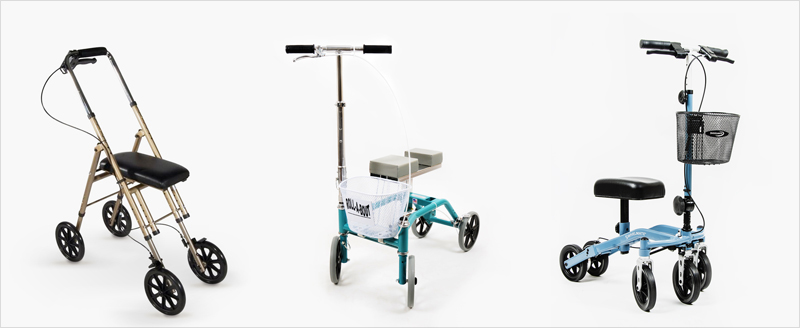
Knee Scooter or Crutches? Why you may need both.
Crutches are the default recommendation for any leg or foot injury where you need to keep weight off your injury or any other related disability. There's evidence to suggest that the existence of crutches can date back at least 5,000 years when the pharaohs ruled Egypt.
 Egyptian Stele (1403–1365 BC) - Wikipedia
Egyptian Stele (1403–1365 BC) - Wikipedia
Their design and construction have evolved since, but its basic premise is the same—transfer weight from your legs to your upper body while providing you with balance and stability. But the biggest drawback still remains—they are very uncomfortable to use and provide limited mobility.
It's now the year 2020 (the year of this writing), and our lives and the way we live it have evolved exponentially. You can make the argument that our lives are a bit more hectic compared to how our ancestors lived. Without getting into too much detail: we have more places to go, things to do, distances to travel, more responsibilities, etc.

A Modern Approach
The knee scooter (also called knee walker) was invented as a response to how uncomfortable and challenging crutches are. Knee walkers are superior at what they do and allow you to do everything you need to with a lot more comfort and minimal effort. But most important of all, it will enable you to travel long distances with very minimal effort. It harnesses the power of one of humanity's greatest inventions—the wheel.
 The first knee scooter models merely supported your injured leg. Steering functionality was later added, then they later evolved with more features and comfort upgrades.
The first knee scooter models merely supported your injured leg. Steering functionality was later added, then they later evolved with more features and comfort upgrades.
Knee scooters today have evolved significantly from the first iteration, which was basically a walker with a knee rest attached—no steering capabilities. Now, there are designs tailored for indoor or outdoor use, models for kids, or enhanced maneuverability.
Luckily, more and more people are becoming aware of knee scooters and decide to use them instead of crutches.
Related: How To Use A Knee Scooter Properly (An Illustrated Guide)
Which One to Choose?
Getting injured sucks, and it's inconvenient. If dealing with a foot injury, you will have to use either crutches or a knee scooter. There's no way around it. You need to be able to move around so you can continue living your life and not putting it on hold.
So what should you get? A knee scooter or crutches?
Let's go over some advantages and disadvantages of crutches and knee scooters:Advantages of Knee Scooters Over Crutches
Disadvantages of Knee Scooters
A Hybrid Approach.
If you choose to go with a knee walker for your recovery, we still advise you to purchase . These come in handy if you have to use stairs at home or work.
If you are able to drive your car, using a crutch or a cane can be useful for when you pack the knee scooter in the trunk. It supports you when you move from the trunk to the front seat.
We've heard from some customers who purchase two knee scooters; they leave one at home and one at work. They use crutches to travel in between.
If you are unable to use a knee scooter, we suggest you take a look at more modern crutches, like the In-Motion Pro, which is designed to be more comfortable and ergonomic to use.
More Great Rent A Knee Walker News & Stories
- •
- •
- •
- •
- •

